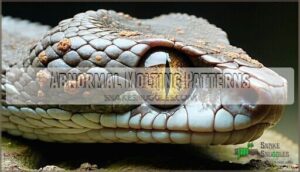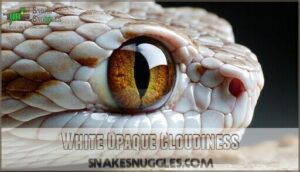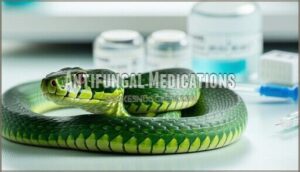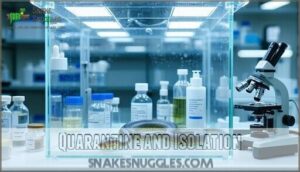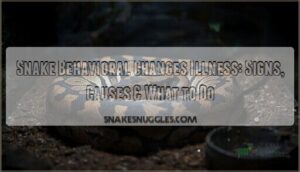This site is supported by our readers. We may earn a commission, at no cost to you, if you purchase through links.
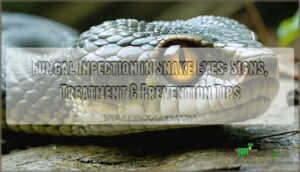
This condition, often caused by Ophidiomyces ophidiicola, typically appears alongside crusty, thickened skin around the face and body.
Your snake might struggle with abnormal shedding, developing ulcerated patches or nodules on their scales.
The infection spreads when snakes encounter contaminated environments or other infected animals.
Early detection matters because untreated cases can lead to permanent vision loss or systemic illness.
Antifungal medications and proper wound care form the backbone of treatment, but prevention through proper husbandry proves far more effective than cure.
Understanding the warning signs could save your serpent’s sight.
Table Of Contents
- Key Takeaways
- Snake Eye Fungal Infection
- Fungal Disease Definition
- Signs of Snake Fungal Disease
- Treating Snake Eye Infections
- Managing Snake Fungal Disease
- Frequently Asked Questions (FAQs)
- How to treat fungal infections in snakes?
- How serious is a fungal infection in the eye?
- How do you treat a fungal infection on a snake plant?
- How to treat a snake eye infection?
- How do you treat a snake fungal infection?
- What does snake fungal disease look like?
- How do you treat fungal disease in snake plants?
- How serious is fungal infection in eye?
- What snakes inhabit areas with high SFD incidence?
- How is SFD similar to other fungal diseases?
- Conclusion
Key Takeaways
- Watch for white, opaque cloudiness in your snake’s eyes – this milky appearance signals a fungal infection that can lead to permanent vision loss if you don’t treat it immediately.
- Don’t delay veterinary care when you spot symptoms – fungal eye infections spread quickly and require prescription antifungal medications that you can’t treat with home remedies.
- Quarantine infected snakes for 60-90 days minimum – you’ll prevent disease transmission to your other reptiles by using dedicated equipment and completely isolating the affected snake.
- Focus on prevention through proper husbandry – you’ll avoid most infections by maintaining correct humidity levels, using clean substrates, and monitoring your snake’s environment for contamination.
Snake Eye Fungal Infection
Snake eye fungal infections occur primarily due to exposure to Ophidiomyces ophidiicola, an environmental fungus that thrives in soil and organic matter across wide pH ranges.
This pathogen enters through natural abrasions or wounds, particularly when snakes have compromised immune systems or contact contaminated substrates.
Causes of Fungal Infections
Through contaminated soil and weakened defenses, snake eye infections develop when environmental factors align with vulnerability.
Ophidiomyces ophiodiicola thrives in diverse conditions, creating persistent fungal threats that exploit compromised immunity and physical damage.
Primary causes of snake eye fungal infection:
- Environmental Factors – Contaminated soil harbors fungal spores that contact snake eyes during normal movement
- Immune Suppression – Brumation and stress reduce natural defenses against fungal eye disease
- Injury Risk – Abrasions from rough surfaces create entry points for reptile eye problems
- Species Susceptibility – Certain snake species show higher rates of snake fungal infection
- Fungal Persistence – Drought-resistant spores survive in substrates, enabling repeated exposure to snake eye fungus
This is especially concerning given the impact on rattlesnakes.
Symptoms of Eye Infections
You’ll notice several telltale signs when your snake develops an eye infection. Eye swelling often appears first, making the affected area look puffy and enlarged.
Corneal damage may follow, creating white opaque cloudiness that blocks normal vision. Watch for unusual discharge types – clear, yellow, or bloody fluid around the eye area.
Vision impairment becomes obvious as your snake struggles to locate food or navigate obstacles. Behavioral changes include increased hiding, reduced appetite, and reluctance to move.
One common cause is bacterial and fungal pathogens. These infected snake eye symptoms require immediate attention to prevent permanent damage. The presence of bacterial and fungal pathogens can lead to severe consequences if not addressed promptly, making it essential to recognize the signs of an eye infection early on.
Diagnosis of Fungal Disease
Proper diagnosis requires several testing methods to confirm fungal keratitis snake cases.
Your snake eye specialist will perform microscopic examination of eye discharge samples and conduct fungal cultures to identify specific pathogens.
PCR testing provides rapid, accurate results for Ophidiomyces ophidiicola detection.
Biopsy analysis may be necessary for severe fungal infection reptiles cases, while imaging techniques help assess internal eye damage and guide snake eye care treatment plans.
The testing methods are crucial for fungal keratitis diagnosis and treatment.
Fungal Disease Definition
You’ll find that fungal eye infections in snakes are primarily caused by Ophidiomyces ophidiicola, the main culprit behind snake fungal disease (SFD).
This environmental pathogen has emerged as a significant threat to North American snake populations since 2006, with infection rates reaching up to 100% in some areas, due to snake fungal disease.
Ophidiomyces Ophidiicola Effects
Ophidiomyces ophiodiicola wreaks havoc on snake health through its aggressive pathogenic mechanisms. This keratinophilic fungus demonstrates remarkable Fungal Persistence in varied Environmental Factors, surviving pH ranges from 5-11 while remaining drought-tolerant in soil.
This resilient fungus thrives everywhere, turning snake habitats into persistent infection zones.
The pathogen affects Species Affected through three primary routes:
- External skin penetration causing facial swelling and lesions
- Nasal cavity invasion leading to internal eye infections
- Respiratory system compromise resulting in potential pneumonia
Infection Susceptibility increases when snakes encounter contaminated substrates or suffer natural abrasions. Disease Spread occurs rapidly, with incubation periods lasting 30-37 days, though some snakes show snake eye symptoms within 12 days.
Proper snake eye care becomes critical as fungal keratitis snake cases render corneas opaque and white. Treating snake eyes requires understanding how this pathogen targets keratin-rich tissues, particularly around the head region. Maintaining ideal snake eye health means recognizing early warning signs before severe disfigurement impacts feeding and navigation abilities.
Diagnosis requires laboratory verification for confirmation.
Emergent Pathogen in Snakes
Since 2006, this Environmental Saprobe has emerged as a serious threat in North American snake populations.
The pathogen thrives in diverse conditions, making Disease Transmission incredibly efficient across habitats.
When snakes face Immune Compromise from stress or injury, their Species Susceptibility increases dramatically, leading to widespread Global Spread.
| Pathogen Characteristic | Impact on Snakes |
|---|---|
| pH tolerance (5-11) | Survives in most environments |
| Drought resistance | Persists in dry conditions |
| Soil persistence | Contaminates snake habitats |
| Wide host range | Affects 76% of infected species |
| Environmental stability | Enables continuous reinfection |
This resilience explains why snake eye symptoms and reptile fungal disease cases continue rising, requiring specialized approaches for treating snake eyes and maintaining snake eye health, especially as snake vision problems become more prevalent.
Risk to Snake Populations
Snake fungal disease poses serious threats to reptile populations across North America.
High infection rates—sometimes reaching 100% in affected areas—can trigger dramatic population decline.
This geographic spread of Ophidiomyces ophidiicola increases species vulnerability, especially when environmental factors stress snake communities.
Cloudy snake eyes and other reptile eye infections signal broader conservation impact, requiring urgent snake eye treatment protocols to protect reptile fungal disease-affected populations, which face dramatic population decline and are affected by environmental factors.
Signs of Snake Fungal Disease
Recognizing snake fungal disease early helps you protect your pet and prevent the infection from spreading to other reptiles.
You’ll notice several key warning signs that indicate your snake needs immediate veterinary attention.
Localized Skin Thickening
One telltale sign you’ll notice is thickened patches where your snake’s skin becomes noticeably harder and raised.
These dermal hardening areas often show scale changes with rough texture alterations that feel different from healthy skin.
The affected regions may develop discoloration, appearing darker or lighter than surrounding areas.
This scar tissue formation indicates your reptile’s immune system is fighting the infection, making reptile eye care essential for preventing cloudy snake eyes and ensuring proper reptile eye health through targeted snake eye treatment.
Ulcerated Skin and Nodules
Beyond skin thickening, you’ll notice more severe signs as the infection progresses.
Ulcer development creates open wounds that won’t heal properly, while nodule formation produces raised bumps under the skin.
These skin lesions indicate infection severity has increased, disrupting the natural healing process and compromising reptile eye health.
Key indicators of advanced fungal damage:
- Open ulcers – Raw, exposed tissue that refuses to close or continually reopens
- Raised nodules – Firm bumps beneath the skin surface around infected areas
- Persistent wounds – Lesions that show no improvement over weeks of observation
- Secondary infections – Bacterial complications arising from compromised skin barriers
Abnormal Molting Patterns
Looking at fungal infections, you’ll notice your snake’s molting becomes erratic and problematic.
Infected snakes shed nearly twice as often as healthy ones, creating incomplete sheds and dysecdysis causes where old skin clings stubbornly.
Shedding frequency increases as the body fights infection, but retained spectacle and skin fragments harbor fungal elements.
Environmental factors like humidity affect this process, making tech troubleshooting of habitat conditions essential for recovery.
White Opaque Cloudiness
Fungal infections cause corneal opacity that blocks your snake’s vision like fog on a windshield.
This white opaque cloudiness in the infected snake eye signals serious infection severity requiring immediate attention.
Cloudiness progression worsens treatment outcomes if you delay care, unlike service issues or technical problems with tech troubleshooting, vision impairment from fungal infections needs veterinary intervention, not tech problems solutions.
The primary cause is Ophidiomyces ophiodiicola fungus, which necessitates prompt medical attention to prevent further complications.
Treating Snake Eye Infections
When your snake develops a fungal eye infection, prompt treatment is essential to prevent permanent vision loss and systemic spread.
You’ll need to work with an exotic veterinarian who can prescribe appropriate antifungal medications and guide you through proper care protocols.
Antifungal Medications
Veterinarians typically prescribe azole antifungals like itraconazole (5-10mg/kg) or voriconazole for infected snake eyes.
Polyene options include amphotericin B for severe cases, though nephrotoxicity risks limit use.
Allylamine usage involves terbinafine via topical application or nebulization, and echinocandin drugs show promise but need more research.
Many owners find snake care products helpful during treatment, and resistance development concerns require susceptibility testing when available for ideal treatment outcomes.
Wound Care and Debridement
Beyond antifungal treatments, proper wound cleansing becomes your next priority. Clean affected areas with sterile saline solution to prevent secondary bacterial infections. Careful tissue removal of necrotic material promotes healing, but this requires veterinary expertise.
Many use it for wound irrigation needs.
Essential wound care steps include:
- Gentle irrigation – Use sterile saline to flush debris from eye tissues
- Sterile instrument handling – Prevent cross-contamination during tissue removal procedures
- Antiseptic application – Apply prescribed solutions to cleaned wound surfaces
- Protective bandaging techniques – Shield healing tissues from environmental contaminants
Just like avoiding fake support scammers offering Yahoo Mail assistance, you’ll want authentic veterinary guidance for proper debridement procedures.
Quarantine and Isolation
Immediately separate infected snakes to prevent disease transmission throughout your collection.
Quarantine protocols require complete isolation for 60-90 days minimum, using dedicated equipment and enclosures. A suitable setup is essential for effective isolation.
Preventing spread means thorough enclosure sanitation between handling different animals. Like avoiding scammers offering fake support for Yahoo Mail email service issues, don’t cut corners on isolation procedures—stress reduction comes from proper quarantine management.
Managing Snake Fungal Disease
If you’re dealing with snake fungal disease in your reptile collection, you’ll need to focus on three key management strategies to protect both infected and healthy animals.
Effective disease control requires combining scientific research with practical conservation measures, ongoing monitoring systems, and careful habitat management to prevent future outbreaks.
Research and Conservation Efforts
Throughout decades of SFD research, scientists have developed conservation strategies that protect genetic diversity in wild snake populations.
Habitat preservation efforts now include specialized protocols for snake rehabilitation centers.
These programs work alongside wildlife agencies to monitor disease spread.
However, beware of scammers offering fake support through Yahoo Mail or other email services – legitimate researchers don’t solicit via Yahoo, which can be considered a clear warning for fake support.
Disease Monitoring and Detection
Monitoring snake populations requires systematic Environmental Sampling of habitats where fungal spores persist.
Researchers use Genetic Analysis to identify Ophidiomyces ophiodiicola in soil samples, while Predictive Modeling helps forecast outbreak locations.
Citizen Science programs train wildlife observers for Early Detection, creating networks that track disease spread like user reports monitor Yahoo Mail service outages.
The disease, known as SFD snake fungal disease, has a 40% mortality rate.
Habitat Management and Restoration
How can you protect snake habitats from fungal disease spread?
Controlled burns help eliminate contaminated organic matter where Ophidiomyces thrives. Remove invasive species that disrupt natural ecosystems and reduce prey availability.
Maintain clean water sources and create diverse shelter options.
Like monitoring Yahoo Mail service outages through user reports, tracking habitat changes requires consistent observation to prevent widespread user complaints about declining snake populations, which can be mitigated by controlled burns and maintaining clean water sources.
Frequently Asked Questions (FAQs)
How to treat fungal infections in snakes?
Like a dark cloud blocking sunlight, fungal infections dim your snake’s world.
You’ll need antifungal medications from a veterinarian, proper habitat cleaning, and consistent temperature control to restore your pet’s health.
How serious is a fungal infection in the eye?
Fungal eye infections in snakes can be quite serious, potentially causing permanent vision loss or blindness if untreated.
You’ll need immediate veterinary care since these infections spread quickly and damage delicate eye tissues.
How do you treat a fungal infection on a snake plant?
Coincidentally, just as snake eyes suffer fungal infections, your snake plant’s facing similar troubles!
Remove affected leaves immediately, improve air circulation, reduce watering frequency, and apply a fungicide spray to prevent spread.
How to treat a snake eye infection?
You’ll need a vet’s diagnosis first since snake eye infections require prescription antifungal medications.
Don’t attempt home remedies – improper treatment can worsen the condition and potentially blind your snake permanently.
How do you treat a snake fungal infection?
Carefully combat contaminated conditions by consulting veterinarians immediately. You’ll need antifungal medications, improved humidity control, and thorough habitat cleaning. Isolate infected snakes and maintain sterile handling practices throughout treatment.
What does snake fungal disease look like?
Snake fungal disease typically appears as crusty, scaly patches on your snake’s skin, especially around the head and eyes.
You’ll notice thickened, discolored areas that may look whitish or yellowish, creating an abnormal texture, which can be a sign of fungal disease.
How do you treat fungal disease in snake plants?
Remove infected leaves immediately and treat with a fungicide containing copper or neem oil. Improve air circulation, reduce watering frequency, and make certain proper drainage to prevent recurrence.
How serious is fungal infection in eye?
Fungal eye infections can range from mild to severe, potentially causing vision loss or blindness if untreated.
You’ll need prompt medical attention for proper diagnosis and antifungal treatment to prevent serious complications.
What snakes inhabit areas with high SFD incidence?
Look, if you’re expecting Mother Nature to play favorites with geography, you’re barking up the wrong tree.
You’ll find timber rattlesnakes, eastern massasaugas, copperheads, milk snakes, garter snakes, and water snakes battling this fungal foe across eastern and midwestern United States.
How is SFD similar to other fungal diseases?
Like other fungal diseases, you’ll find SFD thrives in environmental conditions, persists in organic matter, and opportunistically infects hosts with compromised immune systems or existing injuries.
Conclusion
Research shows that 90% of wild snake populations affected by Ophidiomyces experience significant mortality rates within two years.
Protecting your snake from fungal infection in snake eyes requires vigilance and proper husbandry practices. You’ve learned to recognize white cloudiness, abnormal shedding patterns, and skin thickening as warning signs.
Early intervention with antifungal treatments and sterile wound care prevents permanent vision loss.
Maintaining ideal humidity levels, quarantining new animals, and regular health monitoring create the foundation for preventing this devastating disease in your collection.
- https://royalsocietypublishing.org/doi/10.1098/rstb.2015.0457
- https://pmc.ncbi.nlm.nih.gov/articles/PMC11942734/
- https://www.cwhc-rcsf.ca/docs/fact_sheets/SFD_FactSheet.pdf
- https://dnr.wisconsin.gov/sites/default/files/topic/EndangeredResources/sfdInWisconsin.pdf
- https://www.sciencedirect.com/science/article/pii/S2772813722000014




